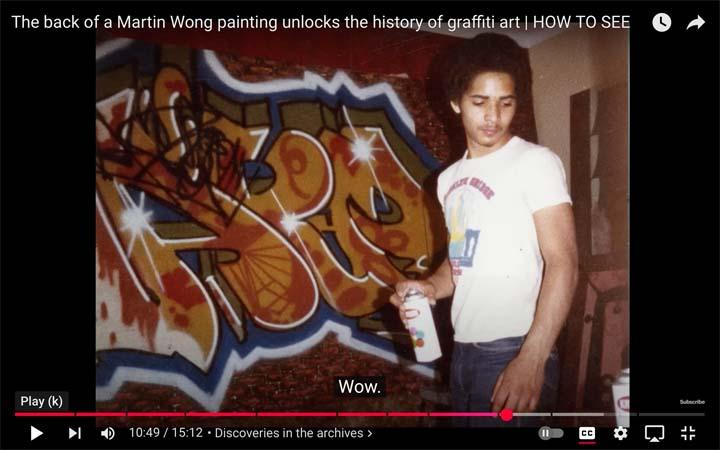DIARY: The Legacy of Martin Wong
Above Ground: Art from the Martin Wong Graffitti Collection, on view at Museum of the City of New York, centers on the many artists who transitioned from illegally writing on subway cars to creating paintings on canvas and exhibiting in galleries and museums. Their works embody an important transitional moment for the movement’s evolution, as it permeated into broader consciousness and significantly influenced global culture.
The exhibition provides a window into a vibrant subculture of young creators and highlights previously unseen treasures from the Museum’s major collection of graffiti-based art donated by the artist Martin Wong in 1994. The collection comprises more than 300 canvases, works on paper and photographs. Among the highlights on view in this exhibition are works in aerosol, ink, and other mediums by seminal figures in the street art movement, including Rammellzee, Lee Quiñones, Sharp, Lady Pink, and Futura 2000. Together, they capture the passions and ambitions of artists transitioning from the street to the walls of prominent galleries in New York and around the world. Below: Stanley (STAN 153) Pratt, “STAN 153” (1985)
But who was Martin Wong? This Chinese-American artist bridged the graffiti art, poetry, and gallery scenes; his drawings and paintings depict the streets and characters around him on the Lower East Side of New York City, where he moved in 1978 from San Francisco at age 32. It was a period of creative liberation but also financial struggle and the rise of the AIDS epidemic. Wong was a magnetic figure on the underground scene: openly gay, generous, and wildly creative. Whenever he sold work, he put the money back into supporting other artists, building an enormous graffiti art collection (what he called “aerosol hieroglyphics”), which he showcased in his short-lived Museum of American Graffiti. Below: Lee Quiñones, “Breakfast at Baychester” (1977)
Wong told filmmaker Charlie Ahern, “The museum of American Graffitti is a privately funded institution devoted to the study of aerosol hieroglyphics. It is hoped that in the future additional grants will enable us to publish and document information crucial to the field before luck and the vagaries of time will have dispersed this material forever.” When the artist, who contracted HIV AIDS realized that he was reaching the end of his life, he donated the entire collection to Museum of the City of New York in 1994, then returned to his family in San Francisco. Below: film still, Sharp153 at work. Watch the film here

A brief documentary film (above) produced by the Museum of Modern Art tells the unknown story of how the back of his painting, Houston Street, got covered in graffiti. Before it became part of MoMA’s collection, rumors circulated about another artwork on its back. When MoMA’s curatorial team replaced the stretcher, they had a chance to study a hidden piece that hadn’t been seen in over 40 years. They invited graffiti artist Sharp (Aaron Goodstone) to the conservation lab to see the painting for the first time since it was shown in 1983. He and filmmaker Charlie Ahearn (Wild Style) share their personal memories of Wong, the impact of his friendship and art, and this intense period in downtown New York. Conversations with conservators, photographs and research discoveries from Wong’s archives, and Ahearn’s video footage of Wong painting in his cramped apartment studio unearth lost paintings and the hidden and moving story of Wong’s “Houston Street.”
Through August 10 at Museum of the City of New York, 1220 Fifth Avenue, New York, NY Info
Martin Wong (b. 1946 Portland, OR; d. 1999 San Francisco, CA) has work in the permanent collections of The Metropolitan Museum of Art, New York, NY; Museum of Modern Art, New York, NY; The Bronx Museum of the Arts, New York, NY; Whitney Museum of American Art, New York, NY; Cleveland Museum of Art, Cleveland, OH; Art Institute of Chicago, Chicago, IL; and San Francisco Museum of Modern Art, San Francisco, CA, among others. Human Instamatic, a comprehensive retrospective, opened at the Bronx Museum of The Arts in November 2015, before traveling to the Wexner Center for the Arts in 2016 and the UC Berkeley Art Museum and Pacific Film Archive in 2017. In late 2022, Martin Wong: Malicious Mischief, the first touring retrospective of Wong’s work in Europe, debuted at the Centro de Arte Dos de Mayo in Madrid, before travelling to the KW Institute for Contemporary Art in Berlin, and the Camden Art Centre in London. Curated by Krist Gruijthuijsen and Agustín Pérez-Rubio, the final leg of the exhibition is currently on display at the Stedelijk Museum, Amsterdam until April 2024. 01V112425





